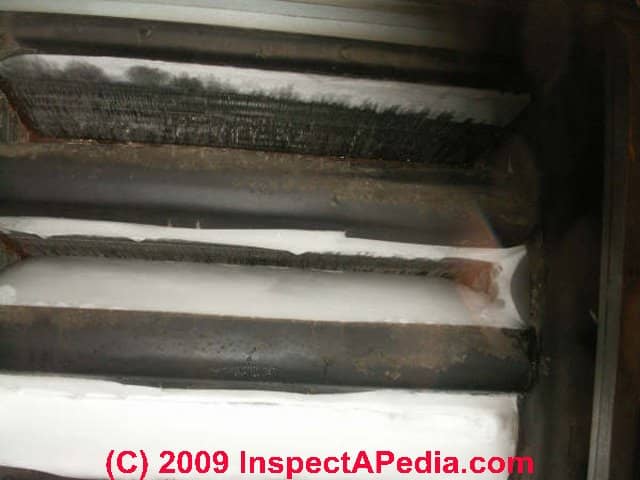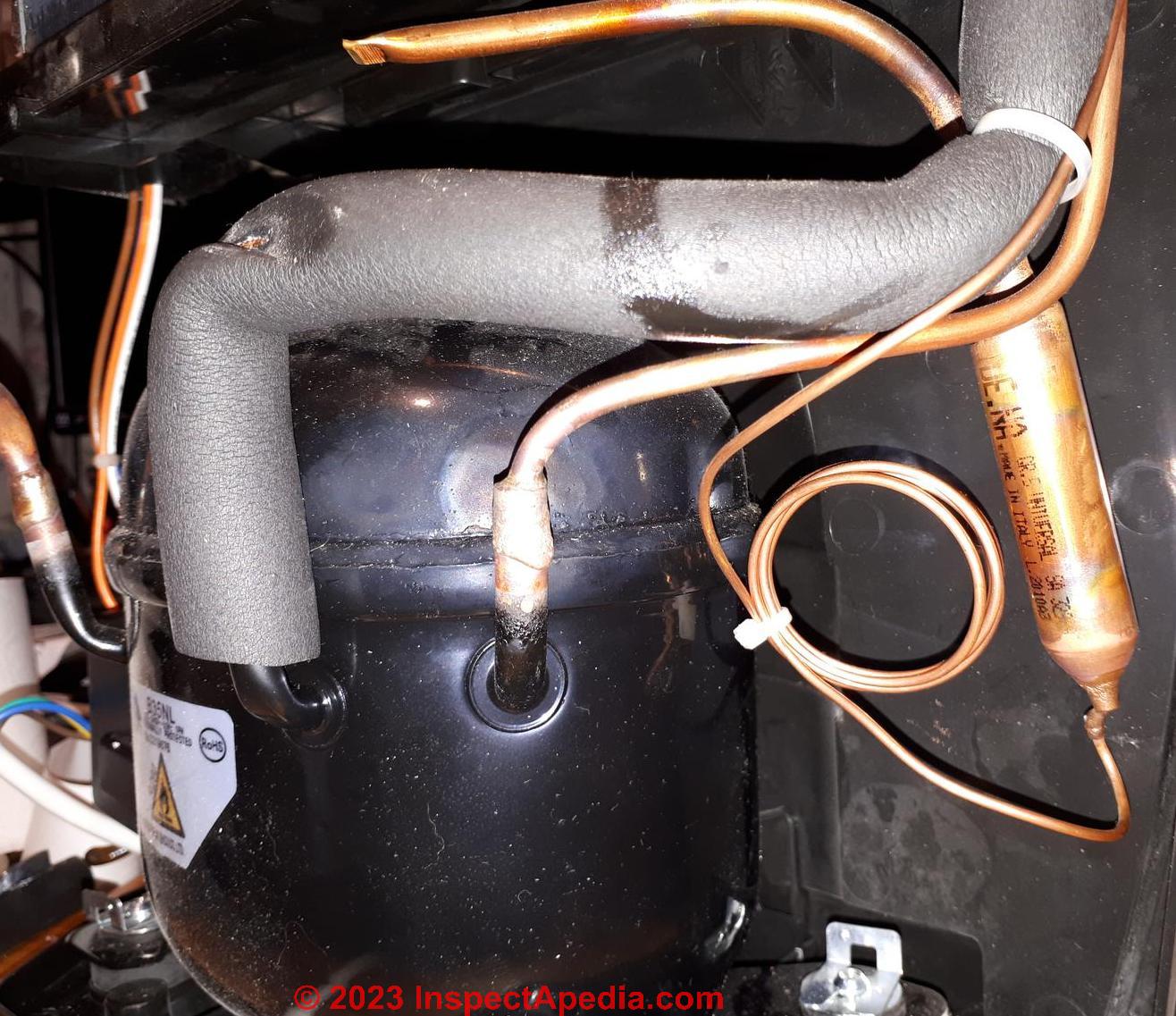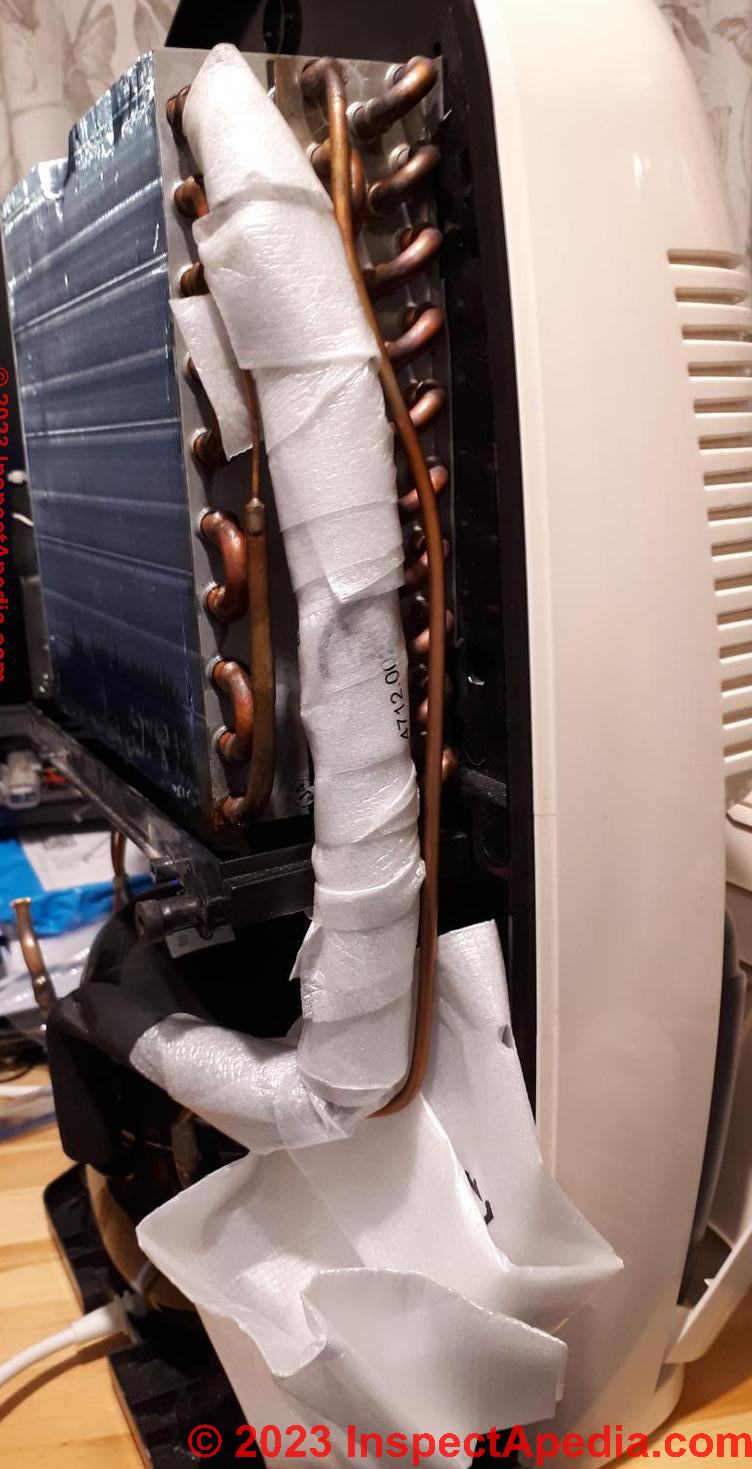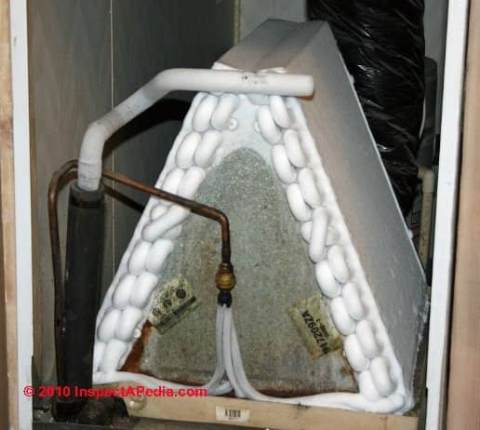 A/C or Heat Pump
A/C or Heat Pump
Cooling Coil or Evaporator Coil Ice or Frost Blockage
Check the air filter first
Why frost or ice forms on the coil or tubing
List of causes of coil frost/ice blockage
- POST a QUESTION or COMMENT about the causes, effects, and cures of icing or frost formation on the air conditioner or heat pump cooling coil
Cooling coil ice & frost formation diagnosis & cure in the air conditioner or heat pump; refrigerant piping line frost causes & remedies.
Diagnose & fix ice or frost blockage of the cooling coil or evaporator coil in an air conditioning / heat pump system.
We explain the causes of cooling coil ice formation and blockage. Some of these causes can be repaired by something as simple as changing a dirty air filter or cleaning a dirty coil or blower fan.
This article series explains the causes & cures for evaporator coil icing: the problems of ice and frost formation in air conditioning system air handler units, blower units, or AHU's, duct work, or other air conditioning system components.
A freezing or frosted A/C coil blocks air flow and leads to loss of cooling.
Our page top photograph of a thoroughly ice-blocked air conditioner evaporator coil was contributed by a reader who described: "I cleaned the coils & installed a new filter - obviously I have a low refrigerant problem. This is an 11 year old furnace/air handler with no history of other problems, but low on Freon."
InspectAPedia tolerates no conflicts of interest. We have no relationship with advertisers, products, or services discussed at this website.
- Daniel Friedman, Publisher/Editor/Author - See WHO ARE WE?
Causes of Ice or Frost Build-up on the Evaporator Coil or Refrigerant Suction Line on an Air Conditioner or Heat Pump System
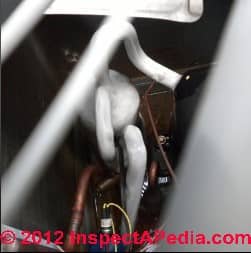
Discussed in this article: Frost or ice build-up on evaporator coils and its effect on cool air flow and mold: Freezing AC coils; Frost or ice formation at air conditioning compressor/condenser units; Ice and condensate problems in air conditioning duct work, why it forms, how bad it can get, how to prevention.
Page top photo of an iced-up air conditioning evaporator coil are courtesy Guy Benfante.
Photo just above: ice formation on refrigerant piping and on the thermal expansion valve in an air conditioner air handler unit - contributed by reader Bill Cauthen.
An air conditioning system will not operate properly and will lose cooling capacity if the evaporator coil becomes blocked with frost or ice.
Even though there is all that ice on the evaporator coil, the cool air flow out of the system will be reduced as air flow across the coil becomes less and less as the ice area grows.
Article Contents
- CHECK THE AIR FILTER FIRST
- WHY ICE FORMS on the COILS
- CONTROL BOARD FAILURE CAUSES ICING
- DIRTY AIR FILTER CAUSES ICING
- HUMIDITY SENSOR FAILURE & COIL ICE
- LOW REFRIGERANT CAUSES ICING & FROST
- SWITCH PROBLEMS & COIL ICE
- OUTSIDE CONDENSER ICE FORMATION
- WET AIR FILTER CAUSES ICING
...
Check the Air Filter Before Calling for Air Conditioner / Heat Pump Repair
Effects of a Dirty Air Filter: Reduced Airflow & Coil Frost
In addition to reduced air flow through the HVAC system, a second result of the reduced air flow due to a dirty air conditioning filter can cause the evaporator coil (the cooling coil) in the air handler to become blocked by ice, stopping or significantly reducing cool air output from the system.
Watch out: Check for a dirty air filter in your air handler or at your ductwork system's return air inlet before calling your HVAC service technician to diagnose and fix an air conditioner or heat pump system with weak air flow at the supply registers and/or with air flow that is too warm when your system is set to cooling or air conditioning mode.
It's embarrassing and costly to have to pay for a service call when all that was needed was a new clean air filter.
A visual inspection
of the cooling coil in the air handler can quickly show whether or not it's ice-covered. If the coil is iced-up and blocked,
turn off the cooling system entirely until the ice has all evaporated and cleared.
Also be sure that your condensate drain is
not blocked and that the water from melting ice is draining to a suitable location rather than into an attic or wall cavity.
Watch out: If you replace all dirty filters on the
system and leave the system turned off long enough for frost or ice to melt and disappear from an ice-blocked oil, and if the coil ices up again when the system is turned back on, your AC or heat pump system has a frost problem that needs repair.
Example of Poor A/C cooling traced to iced coil traced to dirty air filter
Our problem began with a poorly performing unit. The Ice only formed after the visit by a licensed HVAC tech recommended by our insurance company. The technician wanted to install a completely new HVAC system - totally unnecessary as I found today.
I discovered the ice this morning; on climbing into the attic to check the evaporator coil I found that the thermostat control cable had been intentionally crimped in an attempt to break the wire inside.
It's an old unit but now I'm on my own trying to eke out the truth.
BTW the technician never mentioned the possibility of a dirty air filter.
On inspection I found that our air filter was indeed covered and completely blocked with thick dust. Hopefully the coil is dirt free since there is no access. - Jim 5/29/11
Reply:
Jim:
Too bad your service tech missed the clogged filter - you might want to mention to him or her that that's what you found - it might help another customer.
I wouldn't assume the tech tried to sabotage your system, more likely it was someone without experience.Unfortunately it's too easy to recommend replacement of expensive equipment when some careful diagnosis done first might find a very inexpensive and effective solution.
...
Why Frost or Ice Forms on an Evaporator Coil
Photo above: frost has almost completely covered this evaporator coil (cooling coil) in the indoor air handler, blocking air flow across the unit.
Frost line on the cooling coil: Both Air Flow & Refrigerant Charge are Critical
When liquid refrigerant enters the evaporator coil temperatures may be as low as 10 deg F at that point - that is at the top of the coil at the point of refrigerant entry.
In normal operation of a refrigeration system, air movement across the evaporator coil provides enough warmth that frost or ice do not form on the coil.
In fact, as one sees in a refrigeration class, releasing liquid refrigerant into a coil over which air is not being blown will quickly result in frost formation on the coil surfaces, beginning at the point of entry of refrigerant into the coil.
At the point on the cooling coil (with no air blowing across it) where no more frost forms on the coil, we know that there is no more liquid refrigerant in the coil.
That is, at this point in its travel through the cooling coil all of the liquid refrigerant that has been introduced has boiled (evaporated) to a gas. Now as all vapor, the refrigerant begins to absorb sensible heat and its temperature will increase.
There are pressure increases at this point in the coil too, but they are insignificant.
In a refrigeration class demonstration, we learn that one could, given no other data, determine the proper refrigerant charge or better, the proper adjustment of an adjustable refrigerant metering device (Thermostatic expansion valve) by adjusting the refrigerant flow rate into the coil so that the frost line stops just before the end of the coil.
Normal cooling of building air at the cooling coil:
In normal operation an air conditioning system is cooling air by moving it across a refrigerant-cooled "evaporator coil" or "cooling coil" in the air handler.
Dehumidification at the cooling coil:
Cooling air passing over the coil also removes moisture from that air - a key factor in making indoor air comfortable in hot weather.
Normally the moisture that's removed from building air forms condensate on the surfaces of the cooling coil, runs down that surface to a collector pan, and is drained away.
CONDENSATE HANDLING discusses disposing of air conditioning condensate.
...
Diagnosis of frost or ice on the cooling coil in an in-use air handler
 Photo of an iced-up cooling coil courtesy of Bill McNeill.
Photo of an iced-up cooling coil courtesy of Bill McNeill.
- The air flow is too slow or has completely halted across the cooling coil.
The cause of this problem could be as simple as a dirty air filter or it could be crimped, disconnected ductwork or even improperly-sized ductwork. - The refrigerant is not being metered properly into the cooling coil, (too little is being released).
A clogged capillary tube or a frozen, dirty, stuck thermostatic expansion valve can cause this trouble.
Watch out: adding refrigerant to "fix" this problem by raising the compressor head pressure will indeed force more refrigerant through the system.
But if/when that piece of crud blows out of the metering device too much refrigerant will flow back to the compressor, slugging it, perhaps destroying it when liquid refrigerant reaches the compressor internal parts.
See REFRIGERANT METERING DEVICES TEVs & EEVs
and
REFRIGERANT METERING CAPILLARY TUBES
Any or all of those conditions cause the level of refrigerant in the cooling coil to be too low; if there is some refrigerant but not enough the coil may become abnormally cold, freezing the condensate that forms on the cooling coil surface as moisture condenses out of air moving across the coil
This freezing condensate liquid can form frost and may build up into a coil icing problem or frost may appear on the cooling coil's refrigerant suction line.
When the surface of a cooling coil or suction line drops below 32 deg F (say from too little refrigerant in the system or too little flow of warmer air across the cooling coil) frost formation is likely on that surface.
Conversely, when the air conditioning system is working properly the surface temperatures on the cooling coil and on the refrigerant lines stay above 32 deg F
In some installations the evaporator coil tend want to drop below 32 F even in normal operation, but air movement across the coil keeps its temperature higher, and thus avoids freezing.
On some commercial refrigeration or air conditioning systems where lower temperatures are common, a defrost cycle is designed into the equipment.
If an icing problem is occurring on commercial cooling systems, in addition to checking the refrigerant charge and air flow, the service technician will also check out the defrost cycle timer.
...
Why does low refrigerant cause icing on the cooling coil?
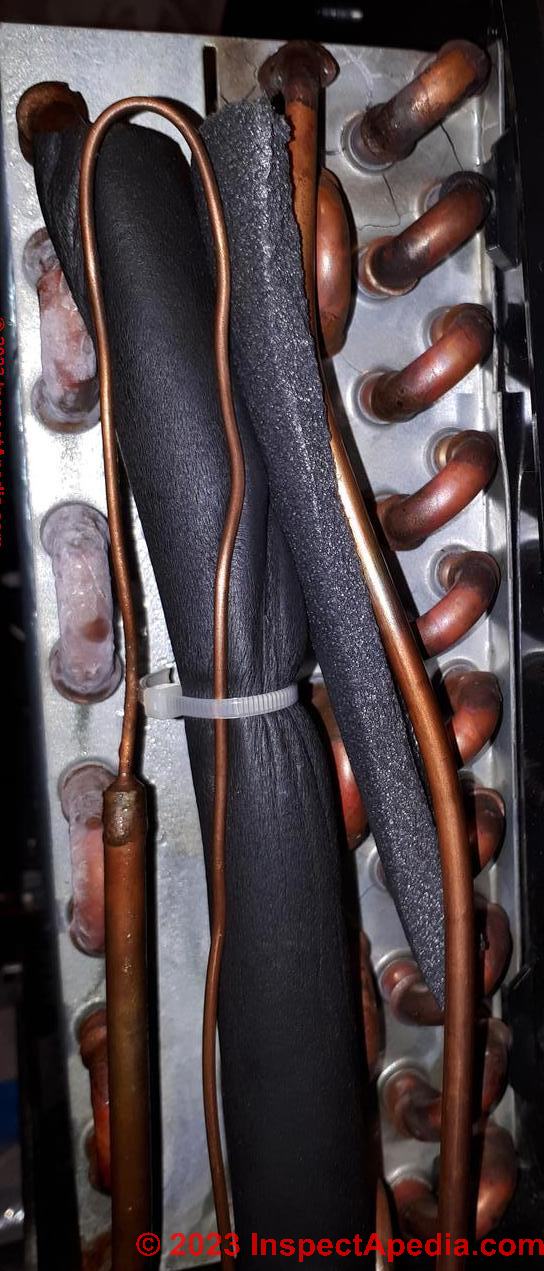 We have a damp house, using domestic dehumidifier to dry the worst parts before building work. I use 4 dehumidifiers, ambient temp generally 62-68degF. Fully sealed units with R134a or R290 gas, mostly bought defective with failed control board which I then fixed.
We have a damp house, using domestic dehumidifier to dry the worst parts before building work. I use 4 dehumidifiers, ambient temp generally 62-68degF. Fully sealed units with R134a or R290 gas, mostly bought defective with failed control board which I then fixed.
I'm getting icing on the cooling coils on a couple of the units, the defrost function kicks in after a while, and the cycle repeats.
New clean filters, even thin and no filters too to try to allow enough warm air to keep the ice at bay, and at times they run for while a collecting water.
Is this likely to be low gas charge?
One unit, nice condition, 2019 model, fairly quickly freezes up, suggesting quite a bit of coolant left in the system.
Struggling with the concept that low gas charge will give me a coil that is too cool - Can someone please explain that please?
Just read a useful article explaining, that low pressure is low temp, leads to high ice formation.
Higher pressure means higher temp (above 32degF) means less or no ice.
I guess I need to understand how to find a very slow leak out of these - or whether that is even feasible. - On 2023-01-15 by Brian -
Reply by InspectApedia Publisher - Causes of ice-up on the cooling coils
@Brian,
Here's a condensed explanation of how low refrigerant causes cooling coil ice:
In basic physics, the greatest energy exchange happens when materials change state such as from liquid to gas (evaporation at an A/C cooling coil) or from gas to liquid (compression in an A/C compressor unit).
In normal operation refrigerant is metered from a high pressure liquid line through a thermostatic expansion valve (TEV) into the low pressure side of an evaporator coil or cooling coil in the air handler. That cools the coil and chills air blowing across the coil.
The proper amount of cooling is controlled by both the metering rate at which refrigerant is squirted through the TEV orifice into the low pressure coil and the low pressure caused by the suction of the (outdoor compressor).
But if the level of refrigerant in a cooling system drops because of a leak, the pressure on the low side will be too low (because the compressor is starved for returning refrigerant, so sucks harder on the suction line, causing an abnormally low pressure in the cooling coil indoors.
That abnormally low pressure on the indoor coil means that when refrigerant is released into the coil it changes state even faster, removing more heat than intended at the coil.
When the cooling coil gets too cold, then any moisture in building air being sent through the coil freezes on the coil surface, forming first frost, then eventually ice.Ultimately the ice can actually block air flow through the coil (and then the cooling system no longer cools building air even though it's running).
Worth your time to read are
REFRIGERANT LEAK REPAIR
There you'll see that we discuss various approaches to finding and repairing a refrigerant leak.
and perhaps
REPAIRS for FROST / ICE on COIL
as other things can cause coil icing - as we also discuss above on this very page.
Don't hesitate to ask follow-up questions.Followup by Brian - my A/C unit uses a capillary tube not a Thermostatic Expansion Valve (TEV)
@InspectApedia Publisher, informative site, thanks.
So:
1. it is unlikely to be economic to have units like mine (see photo) with leaks repaired professionally, they 'only' retail at $2-300
2. it is unlikely to be worthwhile buying gauges and kit to try to repair myself, unless I made a small business of it and be prepared to get some training - though in reality I'm too old for that
3.I want to learn more, regardless. I have seen a copy of Dossat edition 1, 1961. Is that so out of date now that we have R290 etc around in addition to R134a as to not worth bothering with?
Are Althouse and is Modern Refrigeration books a good practical alternative?
Answer by InspectApedia Publisher - find a leak with a halogen leak detector?
@Brian,
I'd first see if you can borrow or even buy a (refrigerant gas) halogen leak detector. Sniff around.If you find a leak that is simple enough, like a perforation, it might be possible to make a makeshift repair using silver solder.
Followup by Brian - I may just try an owner-applied patch on a leak in the refrigerant line
@InspectApedia Publisher, Thanks for your suggestion. If I did get a leak detector, and found something accessible, I presume that I couldn't solder it without draining down - I read that on your site elsewhere.
On the basis that the unit would be economically scrap otherwise, It might be tempting to try an epoxy patch in the first instance, and then top it up with a refill that I have for the car using a BPV31.
If it gets a couple of years service to help dry the laundry and saving $$ on the energy cost of a clothes dryer then it could be worth a try.
Reply by InspectApedia Publisher
@Brian,
With the caveat that of course we're not following practices that a trained HVAC tech would use, sure you can try a blob of expoxy or silver solder.Comment by Brian - I'm a P.E. but not in Refrigeration - I might take some shortcuts
@InspectApedia Publisher, Thank you. I am a professional engineer in the railroad and petrochem electrical/electronic field, with 2 years o go until retirement.
I appreciate that my suggestion would make a true HVAC pro's toes curl, and as a perfectionist mine would curl too, lol.
Warnings by InspectApedia Publisher
@Brian,
FYI - a consideration is that the high heat needed for brazing or silver soldering can produce some ash debris inside the tubing that in turn can foul parts in the system like a thermostatic expansion valve.For that reason, if a tech has to cut and solder the refrigerant system she'll add a special filter dryer to the system at the same time, and might (should) return later to change that device out.
OTOH I'm doubtful that single teensy solder blot quickly done, maybe not even with the right (high temp silver) solder has to cause all that trouble.Further Discussion by Brian - curious noise & vibration from mis-behaving cooling unit compressor
Whilst awaiting my halogen sniffer I have been testing one unit that is quite recent, in very good condition but still tends to ice up.
It had a blown circuit board which I repaired. It makes a curious noise every 1-2 seconds, a bit like a kettle that has just been switched on. It lasts for 1-1.5s, is silent briefly before repeating.
I'm getting around 48 and 25 degC at top and bottom of the condenser and around 6degC at the compressor return. Charge is 60g of R290. It sounds like the noise is loudest on the cap tube.
Now it gets interesting. The evap cool is lightly frosted, and blow me down, when I hear the noise, the frosting changes in lockstep. I wouldn't have believed it had I not seen it, it frosted and thawed almost as quickly as a tick on a clock.
Holding the coiled up cap tube in my fingers, I feel vibration there and the temp drops by a few tenths each time the noise occurs. Coordinating sound and vibration, I'd guess that the refrigerant may be boiling in the cap tube forcing a surge of vapour into the evap coil.
I'm experimenting with whether heating or cooling the cap coil makes things better or worse. With some insulation around the coil and the wide part before it, the icing is less, but the boiling - if that is what it is - continues and the noise is still there. This is quite an interesting phenomenon.
Continuation by Brian,
@Brian, now trying with further insulation over most of the length of the cap tube. Not very good, thin temporary strips of packing. Noise persists but not so loud, still icing, but not so much. On 2023-01-18
Comments by InspectApedia Publisher - Insulation won't fix a refrigerant leak and may be unsafe; sounds as if your A/C control was cycling on and off
@Brian,
Interesting band-aid, won't fix the leak, of course.Watch out: Be sure no insulation can get sucked into moving parts like a fan (fire hazard).
Sounds as if a control was cycling on and off. I don't think those devices use a thermostatic expansion valve, more likely a cap tube, but if it was a TEV, that could be the problem
More details by Brian - frost on ends of cooling coil tubing
@InspectApedia Publisher, Hi thanks for your comments.
Yes just a cap tube in there, nothing thermostatic. So it is a bit better to keep the cap tube away from the warmer parts, I relocated the cap tube and tried a piece of shielding between it and the hot condenser coil input line It looked better last night but today we still had continuous freeze/defrost cycles.
So, you believe this to be low gas. May I ask your learned opinion on this last point:
Having remeasured the condenser coil temp last night, I found that it lost about 10degC across the top 1/6th of the coil, from then it lost only another degree across all the remainder of the cost - temp 26degC. Is that a low gas symptom, instead of expecting a gradual temp drop all along the coil?
Room temp was about 17degC.
by InspectApedia Publisher - low refrigerant contributes to problem
@Brian,
I'm guessing myself, here but yes that sounds like low refrigerant.
Once the charge gets low enough, there isn't enough refrigerant being metered into the low side of the coil to cool it all the way to its end.
I infer this from typical charging instructions that had the tech add refrigerant to bring the frost line just to the end of the coil.by Brian
@InspectApedia Publisher, Thanks. It may be low gas.
However, I'm wondering if the temperature across the condenser is giving me a clue in that the constant temp of 26degC across the lower 80+% may mean that the condensed refrigerant is backing up upstream of the filter/strainer and the cap tube.Possibly a restricted/partial blockage, the symptoms of this, apparently, can resemble those of low gas.
My non-HVAC-engineer brain is surmising that: Cyclically, the head pressure increases until more refrigerant squirts past the partial restriction, and then the pressure drops, and flow reduces again.The squirts of refrigerant, will boil/evaporate/flash quickly, shooting pulses of vapour and gas into the evap.
I've improved things by keeping the cap tube cooler (putting it closer to the suction line). It isn't right yet, but it is better.It runs on faster fan speed without icing unless the room temp is too low. This is a band-aid, not a repair.
I'm reading up, and still tinkering, but at least it is working tolerable.It may be my imagination, but flicking/tapping the coil/filter connection region may make things better, maybe dislodging a piece of manufacturing debris which could correlate with restricted cap tube/flow symptoms.
by InspectApedia Publisher
@Brian,
That's interesting. Indeed cap tubes are more-easily clogged by even the smallest bits of debris.On the other hand, if a blast of refrigerant due to pressure increase pushed past, why wouldn't that have cured the blockage? If there is cycling behavior at truly regular intervals that itself may be diagnostic.
...
Wet air filter blocks airflow and causes coil icing
If air filter gets wet does it block air flow causing frost to build up on coils? - Anonymous
Reply: yes, and there is a possible safety hazard too
Anon
Yes a wet air filter will severely block air flow, just like a dirty air filter.
When airflow is blocked across the evaporator coil then the coil temperature drops too low (it's not being warmed by air passing over it) and frost, then ice form, blocking air flow and ultimately causing the air conditioner to stop cooling building air as well as reducing air flow out of the supply vents.
Watch out: and worse, if the filter is located where it may be drawn into the air handler where it encounters moving parts it would be an unsafe condition, even risking a fire.
...
Meaning of Low Refrigerant & Coil Icing: cooling coil icing & bubbles in the refrigerant sight glass:
My A/C just stopped cooling (2 year compressor / condenser unit). Tech said freon very low. Charged system with 6 lbs of R22, checked quickly for obvious leaks and left. The site glass indicator had a solid flow of Freon with micro bubbles.
Noticed that the larger suction line never got cold. The smaller liquid line was warm for a short while.
AC vent air was never cool and less than 24 hours, the glass indicator shows low freon (gurgling - large bubbles) and the evaporator coil freezes.
Do not notice any obvious oil leaks. Can a compressor be the source of a freon leak and prevent the large suction line to never get cold to the touch? (Aug 5, 2012) Rob C said:
I added R-22 2lb 4 days ago, now it is doing the same, coil is frozen up all the way to the suction line at the outdoor unit. (Sept 1, 2012) juan
My question is if there is leak in the system or restriction in the liquid line, or air flow problem besides a leak in the system, replaced air filter, indoor fan motor seems that it is not running properly,but the fan capacitor is okay. - (Sept 7, 2012) Mike
The small capillary lines are freezing up on my A/C system just like the picture at the top of this page. The capillary tube lines reeze almost instantly when the system is tuned on. It just seems to be the small lines where they split at the joint at the larger line. Any suggestions?? thanks in advance
Reply: low refrigerant can cause ice or frost on the coil
Rob and Juan: Bubbles in the sight glass and gurgling usually means low refrigerant. If the tech gave the system a full-up charge then you've got a big refrigerant leak.
The compressor motor is hermetically sealed on most residential systems - not likely that that can is leaking - if it were you'd see oil deposits at a seam or fitting.
Watch out: a homeowner DIY job of adding refrigerant is risky if the homeowner isn't trained and equipped for working on refrigerant equipment. You don't have the gauges nor the charging equipment to assure that the charge quantity is correct, you risk pushing dirt and contaminants into the system that cause further malfunction, and an overcharge can destroy the compressor.
...
Control board error can cause cooling coil icing
Another cause of icing is the control board not sending the signal to the compressor to shut down meanwhile the blower has soppped and the louvers has closed.
Replace the control board or install a new separate thermostat. - (July 24, 2012) rhansen79@yahoo.com
Reply: Thanks so much Mr. Hansen for your important contribution to the diagnosis & repair of coil icing.
...
Frozen pipe outside my air conditioner unit - bad switch not lost freon?
Pipe frozen at outside unit and the inside unit would stop running but the outside unit would continue to run.
I made an appointment for service. The tech came out and checked my freon level, he said it was fine and suggested that my problem may be the compressor.
I told him that I was out of town all week and did not notice any problem before I left. He then told me that severe weather came through the area a few days prior and I should call my insurance agent to file a claim. The insurance agent sent someone out to check it.
This turned out to be another heating and air company.
This guy said that the freon levels were good but switch needed to be replaced. He replaced it but three weeks later I have the same problem and have no idea what to look at myself to see what the problem could be. My air filter is new.
Both units come on and off together. No registers are closed. I checked for dirty coils outside then went into the attic, up there the coils had frost on them hours after I shut everything down. - Jason 7/30/11
I have the same problem as Jason, only it is intermittent (once every two weeks or so). Ha,ve had two contactors(?) replaced since last year. What can I tell repairman to test next? - Jackie 8/2/11
Reply:
Jason if your inside unit (air handler, cooling coil, blower fan) stops running, I'm not clear how a bad outdoor compressor would make the inside air handler unit stop.
A bad switch can be the culprit and sometimes even a replacement part can be bad, or the conditions that burned up the first switch could burn up the second one, indicating that more careful testing and diagnosis to find a root cause are needed.
Jackie, I would be careful not to be too directive to the repairman; but I would press for an explanation of why the same part keeps being replaced; it's natural to suspect that a different problem is damaging the part that's being swapped out.
...
Cause of icing on the outside condenser unit
My outside condenser keeps freezing up with ice, I cleaned the coils in the outside unit and the attic unit, I can feel strong air coming out of vents but not very cold.
WhenI turn the fan on for about an hour or two the ice is melted outside on the condenser and lines and blows real cold air, however the ice formation occurs daily about mid afternoon and thermostat just stays at 75 degrees, then i turn the fan on again to defrost.
Also has new air filter and electric bill is through the roof. (Oct 1, 2012) jb
Reply:
Strong but not cool air flow argues that the problem is not a blocked coil, but possibly a wrong (low) refrigerant charge or a compressor or refrigerant control or metering problem.
It's time to get some onsite help from an experienced air conditioning service technician.
...
New 5G Coil was encased in ice as was the refrigerant piping - humidity sensor was bad
The new 5G coil was encased in ice and well as the indoor and outdoor pipes.
After shutting system off and letting it thaw, it was determined that the sensor that reads the humidity was bad and the tech stated the unit was continuously running trying to de-humidify and that caused the freezing.
New sensors were to be ordered. Ie. The freon levels were good. Please give your opinion. Thanks. (Feb 21, 2013) Angelica
Reply:charge.
Certainly I'd start by trusting the on-site service technician who says that an alternative explanation for coil icing was that the cooling unit never stopped running because of a e or humidity sensor. That's a plausible explanation.
The most common cause for coil icing is low refrigerant - due to a refrigerant leak or due to an improper
Thank you to our readers for their generous comments
(July 29, 2011) Henry said: Thank you so much for this web site and your detailed information.
(May 29, 2011) Don said: Great article! Takes some of the "mystery" out.
(May 24, 2011) Bahi said: Information is very valuable We hope to be in the hands of every technician...Thanks
(May 23, 2011) Cnoel said: Great work on the information for cooling freeze-up problems and ways to handle the varies causes.
(Apr 26, 2011) Ali said: Thanks, this was very helpful!
(May 25, 2012) Danny said: This article/s had helped me a lot in understanding the probable cause of my icing evaporator which causes the unit to stop working correctly, especially this hot, hot remaining summer days in the Philippines. Our service provider will be here very soon. Thanks a lot!
(July 5, 2012) Anonymous said: very good detailed information best on the internet thanks
...
...
Continue reading at FROST / ICE IMPACT on A/C or select a topic from the closely-related articles below, or see the complete ARTICLE INDEX.
Or see FROST BUILD-UP on AIR CONDITIONER COILS FAQs - questions and answers posted originally on this page.
Or see these
Recommended Articles
- COOLING COIL or EVAPORATOR COIL
- DIAGNOSTIC GUIDE A/C or HEAT PUMP
- DIAGNOSTIC DETAILS A/C or HEAT PUMP
- FROST BUILD-UP on AIR CONDITIONER COILS
- FROST / ICE IMPACT on A/C
- HEAT PUMP OUTDOOR UNIT DEFROST CYCLE
- REPAIRS for FROST / ICE on COIL
- REFRIGERANT LINE FROST
- HEAT PUMP OUTDOOR UNIT DEFROST CYCLE
- MANUALS & PARTS GUIDES - HVAC - home
- REFRIGERANT LEAK REPAIR
- REPAIRS for FROST / ICE on COIL
- WATER & ICE IN DUCT WORK
- WET CORRODED DUCT WORK
Suggested citation for this web page
FROST BUILD-UP on AIR CONDITIONER COILS at InspectApedia.com - online encyclopedia of building & environmental inspection, testing, diagnosis, repair, & problem prevention advice.
Or see this
INDEX to RELATED ARTICLES: ARTICLE INDEX to AIR CONDITIONING & HEAT PUMPS
Or use the SEARCH BOX found below to Ask a Question or Search InspectApedia
Ask a Question or Search InspectApedia
Try the search box just below, or if you prefer, post a question or comment in the Comments box below and we will respond promptly.
Search the InspectApedia website
Note: appearance of your Comment below may be delayed: if your comment contains an image, photograph, web link, or text that looks to the software as if it might be a web link, your posting will appear after it has been approved by a moderator. Apologies for the delay.
Only one image can be added per comment but you can post as many comments, and therefore images, as you like.
You will not receive a notification when a response to your question has been posted.
Please bookmark this page to make it easy for you to check back for our response.
IF above you see "Comment Form is loading comments..." then COMMENT BOX - countable.ca / bawkbox.com IS NOT WORKING.
In any case you are welcome to send an email directly to us at InspectApedia.com at editor@inspectApedia.com
We'll reply to you directly. Please help us help you by noting, in your email, the URL of the InspectApedia page where you wanted to comment.
Citations & References
In addition to any citations in the article above, a full list is available on request.
- Modern Refrigeration and Air Conditioning, A. D. Althouse, C.H. Turnquist, A. Bracciano, Goodheart-Willcox Co., 1982 (or a later edition)
- Principles of Refrigeration, R. Warren Marsh, C. Thomas Olivo, Delmar Publishers, 1979 (or a later edition)
- Refrigeration and Air Conditioning Technology, 5th Ed. (or a later edition), William C. Whitman, William M. Johnson, John Tomczyk, Cengage Learning, 2005, ISBN 1401837654, 9781401837655 1324 pages
- Thanks to inspector Bill McNeill for providing a photograph of an ice-blocked evaporator coil or cooling coil in an air conditioning air handler unit. Mr. McNeill can be reached at wem007@hotmail.com
- Thanks to reader [Anonymous] for providing a photo of a totally blocked cooling coil on an 11-year-old system that was low on refrigerant. August 2010.
- Thanks to reader Tom Balla for suggesting clarification on ice formation on the air conditioning system suction line.
- Thanks to reader R. Hansen for adding air conditioning / heat pump control board failure tip that explains another cause of cooling coil or system icing. Email: rhansen79@yahoo.com July 2012
- In addition to citations & references found in this article, see the research citations given at the end of the related articles found at our suggested
CONTINUE READING or RECOMMENDED ARTICLES.
- Carson, Dunlop & Associates Ltd., 120 Carlton Street Suite 407, Toronto ON M5A 4K2. Tel: (416) 964-9415 1-800-268-7070 Email: info@carsondunlop.com. Alan Carson is a past president of ASHI, the American Society of Home Inspectors.
Thanks to Alan Carson and Bob Dunlop, for permission for InspectAPedia to use text excerpts from The HOME REFERENCE BOOK - the Encyclopedia of Homes and to use illustrations from The ILLUSTRATED HOME .
Carson Dunlop Associates provides extensive home inspection education and report writing material. In gratitude we provide links to tsome Carson Dunlop Associates products and services.


